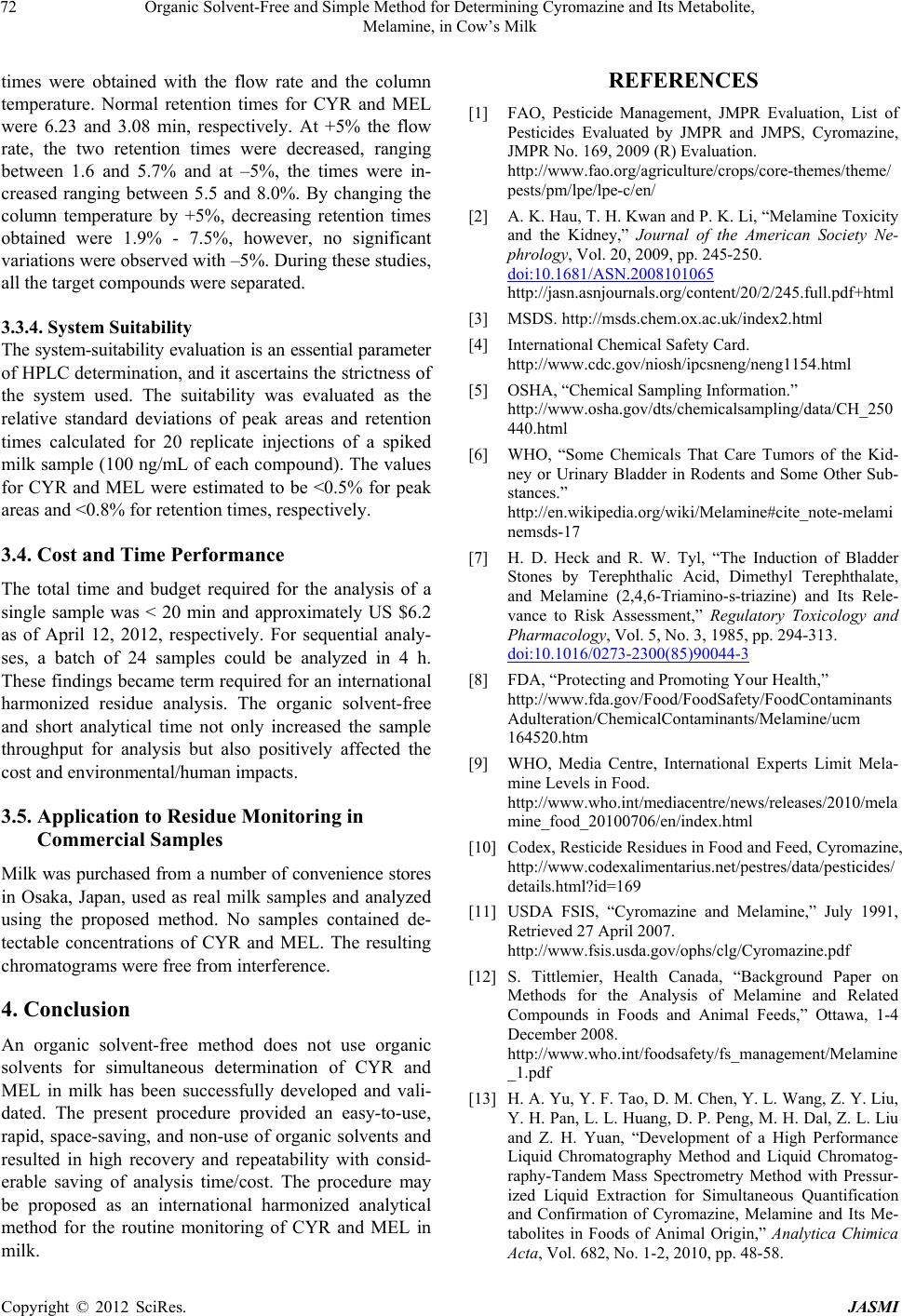
Organic Solvent-Free and Simple Method for Determining Cyromazine and Its Metabolite,
Melamine, in Cow’s Milk
72
times were obtained with the flow rate and the column
temperature. Normal retention times for CYR and MEL
were 6.23 and 3.08 min, respectively. At +5% the flow
rate, the two retention times were decreased, ranging
between 1.6 and 5.7% and at –5%, the times were in-
creased ranging between 5.5 and 8.0%. By changing the
column temperature by +5%, decreasing retention times
obtained were 1.9% - 7.5%, however, no significant
variations were observed with –5%. During these studies,
all the target compounds were separated.
3.3.4. System Suitability
The system-suitability evaluation is an essential parameter
of HPLC determination, and it ascertains the strictness of
the system used. The suitability was evaluated as the
relative standard deviations of peak areas and retention
times calculated for 20 replicate injections of a spiked
milk sample (100 ng/mL of each compound). The values
for CYR and MEL were estimated to be <0.5% for peak
areas and <0.8% for retention times, respectively.
3.4. Cost and Time Performance
The total time and budget required for the analysis of a
single sample was < 20 min and approximately US $6.2
as of April 12, 2012, respectively. For sequential analy-
ses, a batch of 24 samples could be analyzed in 4 h.
These findings became term required for an international
harmonized residue analysis. The organic solvent-free
and short analytical time not only increased the sample
throughput for analysis but also positively affected the
cost and environmental/human impacts.
3.5. Application to Residue Monitoring in
Commercial Samples
Milk was purchased from a number of convenience stores
in Osaka, Japan, used as real milk samples and analyzed
using the proposed method. No samples contained de-
tectable concentrations of CYR and MEL. The resulting
chromatograms were free from interference.
4. Conclusion
An organic solvent-free method does not use organic
solvents for simultaneous determination of CYR and
MEL in milk has been successfully developed and vali-
dated. The present procedure provided an easy-to-use,
rapid, space-saving, and non-use of organic solvents and
resulted in high recovery and repeatability with consid-
erable saving of analysis time/cost. The procedure may
be proposed as an international harmonized analytical
method for the routine monitoring of CYR and MEL in
milk.
REFERENCES
[1] FAO, Pesticide Management, JMPR Evaluation, List of
Pesticides Evaluated by JMPR and JMPS, Cyromazine,
JMPR No. 169, 2009 (R) Evaluation.
http://www.fao.org/agriculture/crops/core-themes/theme/
pests/pm/lpe/lpe-c/en/
[2] A. K. Hau, T. H. Kwan and P. K. Li, “Melamine Toxicity
and the Kidney,” Journal of the American Society Ne-
phrology, Vol. 20, 2009, pp. 245-250.
doi:10.1681/ASN.2008101065
http://jasn.asnjournals.org/content/20/2/245.full.pdf+html
[3] MSDS. http://msds.chem.ox.ac.uk/index2.html
[4] International Chemical Safety Card.
http://www.cdc.gov/niosh/ipcsneng/neng1154.html
[5] OSHA, “Chemical Sampling Information.”
http://www.osha.gov/dts/chemicalsampling/data/CH_250
440.html
[6] WHO, “Some Chemicals That Care Tumors of the Kid-
ney or Urinary Bladder in Rodents and Some Other Sub-
stances.”
http://en.wikipedia.org/wiki/Melamine#cite_note-melami
nemsds-17
[7] H. D. Heck and R. W. Tyl, “The Induction of Bladder
Stones by Terephthalic Acid, Dimethyl Terephthalate,
and Melamine (2,4,6-Triamino-s-triazine) and Its Rele-
vance to Risk Assessment,” Regulatory Toxicology and
Pharmacology, Vol. 5, No. 3, 1985, pp. 294-313.
doi:10.1016/0273-2300(85)90044-3
[8] FDA, “Protecting and Promoting Your Health,”
http://www.fda.gov/Food/FoodSafety/FoodContaminants
Adulteration/ChemicalContaminants/Melamine/ucm
164520.htm
[9] WHO, Media Centre, International Experts Limit Mela-
mine Levels in Food.
http://www.who.int/mediacentre/news/releases/2010/mela
mine_food_20100706/en/index.html
[10] Codex, Resticide Residues in Food and Feed, Cyromazine,
http://www.codexalimentarius.net/pestres/data/pesticides/
details.html?id=169
[11] USDA FSIS, “Cyromazine and Melamine,” July 1991,
Retrieved 27 April 2007.
http://www.fsis.usda.gov/ophs/clg/Cyromazine.pdf
[12] S. Tittlemier, Health Canada, “Background Paper on
Methods for the Analysis of Melamine and Related
Compounds in Foods and Animal Feeds,” Ottawa, 1-4
December 2008.
http://www.who.int/foodsafety/fs_management/Melamine
_1.pdf
[13] H. A. Yu, Y. F. Tao, D. M. Chen, Y. L. Wang, Z. Y. Liu,
Y. H. Pan, L. L. Huang, D. P. Peng, M. H. Dal, Z. L. Liu
and Z. H. Yuan, “Development of a High Performance
Liquid Chromatography Method and Liquid Chromatog-
raphy-Tandem Mass Spectrometry Method with Pressur-
ized Liquid Extraction for Simultaneous Quantification
and Confirmation of Cyromazine, Melamine and Its Me-
tabolites in Foods of Animal Origin,” Analytica Chimica
Acta, Vol. 682, No. 1-2, 2010, pp. 48-58.
Copyright © 2012 SciRes. JASMI